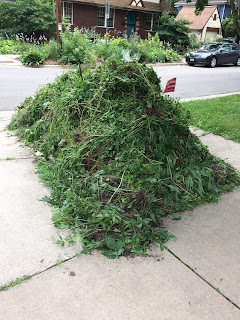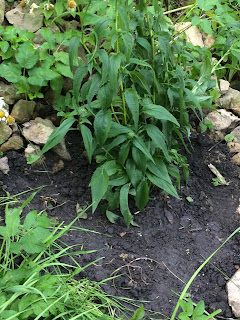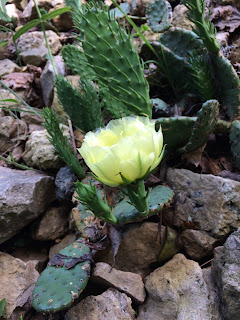The morning's session reminded me of Carl Sandburg's poem, Weeds. It includes a view from the weeds' perspective while pointing out their persistence in the face of societal norms.
From the time of the early radishes
To the time of the standing corn
Sleepy Henry Hackerman hoes.
There are laws in the village against
weeds.
The law says a weed is wrong and shall
be killed.
The weeds say life is a white and lovely
thing
And the weeds come on and on in
irresistible regiments.
Sleepy Henry Hackerman hoes; and the
village law uttering a ban on
weeds is
unchangeable law.
On the first step, starting from the left, is Joyce, Jody and Larry. Joyce recently traveled to Easter Island. We heard about her adventure. Jody and Larry were "newbies." In the back row is Laura, me and Ann N. with the blue hat and doing a royal like wave. Thanks to each of you for spending part of your day tending the Gardens. We made much progress against the irresistible regiments.

Here's Ann N. striking a pose. We have known Ann and her husband, Don, or at least thirty years. Their daughter was friends with our daughter Emily since pre-school. Staying in one place (Madison) overtime has its benefits and this includes the pleasure of knowing the same people through different phases of life.
Here's Larry pulling aggressive plants. The pinkish plants are Joe Pye Weed. Friends from West Bend donated them several years ago and they are thriving. Larry, before he retired, grew and sold flowers. He still has a small greenhouse. Larry told me that he sold Joe Pye blossoms to florists.
Here's Laura and Joyce teaming up clearing out weeds from a section on the Regent side of the Gardens. They also removed the two aggressive plants.
The two working side-by-side represent the partnership between Dudgeon Monroe and Regent Neighborhood Associations that supports Prospect Gardens. Joyce lives in the Regent Neighborhood and Laura is a resident of Dudgeon Monroe.
There is always time to talk with neighbors or those just passing by. Here is Joyce talking with a neighbor she knows. I stopped to admire the baby in the stroller. She has wonderful long eye lashes. She did not pay much attention to me.
Earlier in the day I enjoyed an exchange with a stranger entering the ramp on his bike. He stopped and we chatted. I learned that he knew Clifton Hillegrass, a Nebraska native, who started CliffsNotes in 1958. The stranger explained how different professors working on CliffsNotes editions would meet in his home and how Hilegrass made millions while increasing the income of other professors.
We also shared our fondness for Burlington, Vermont, a place he once lived. I often traveled to Burlington when I was an educational consultant for The Network Inc, an educational consulting firm located in Andover, Massachusetts. This was my first position after earning a doctorate in education from Indiana University in 1983. I traveled throughout the New England States and occasionally New York and New Jersey working with primarily staff of state special education agencies.
Our daughter, Emily, was born in Lawrence, MA a town bordering Andover. The New England states have a special place in my heart. We moved back to Wisconsin in 1986 so Emily would experience her grandmothers, and her many aunts, uncles and cousins.
We all have our stories to tell and I enjoy hearing them from those passing by as I tend the Prospect Gardens. Story telling along the path shows how green spaces promote human connections. Sometimes, instead of a short story, the connection is a heartfelt "thank you for your work" from a walker or a biker whizzing by.

By noon our efforts resulted in this large pile of plant material. This morning, July 23rd, I returned to the Gardens for another two and a half hours of weeding. The additions to this pile made it the largest of the season. Perhaps a candidate for the book of Guinness World Records?
A city crew will do a pick up sometime this week. Thanks Ryan, City Engineering, for arranging the pick up and to the the crew who always follow through.
I also enjoyed this morning's chats with Ed, Derek, Richard and Susan. I very much enjoyed Richard's and Susan's singing of Happy Birthday, as they came up the bike ramp.
It's so nice to continue in a birthday celebration mood.
Finally, we come to the banner. This is just one of the ways I am trying to recruit more volunteers and especially those that are younger than me and the age of our regular volunteers. Most of us are over 60 and I just celebrated my 74th birthday. I hope to have a few more good years of gardening. Yet, inevitably I will need to give up tending the Prospect Gardens. Aging is a process of letting go.
Aging volunteers coupled with the challenge of recruiting younger ones is an issue faced by other lead volunteers heading up other prairie gardens along the Southwest Path. I'm spending more time this season on this issue and will in the near future.
If you are in the Madison area and not a regular volunteer, please consider volunteering. If you have any ideas about recruiting younger volunteers, I would like to hear from you.
Aging volunteers coupled with the challenge of recruiting younger ones is an issue faced by other lead volunteers heading up other prairie gardens along the Southwest Path. I'm spending more time this season on this issue and will in the near future.
If you are in the Madison area and not a regular volunteer, please consider volunteering. If you have any ideas about recruiting younger volunteers, I would like to hear from you.
























